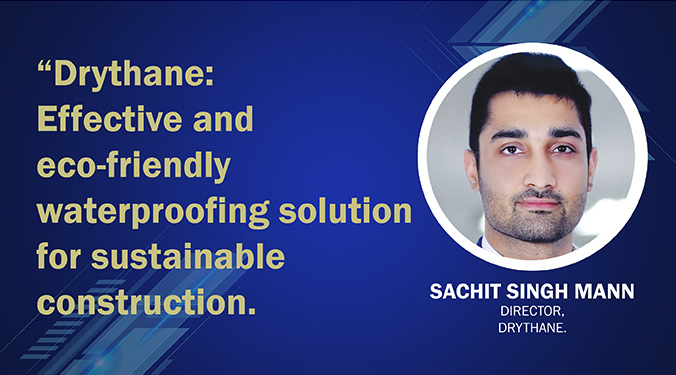Drythane – The sustainable waterproofing solution with no-VOC components

Sachit Singh Mann, Director at Drythane, discusses their eco-friendly waterproofing solutions’ advantages and unique features.
What are the different types of waterproofing chemicals available on the market, and how do they vary in their application methods and effectiveness?
Various types of waterproofing chemicals are available on the market, each with its own characteristics and application methods. Bituminous coating is a popular option, providing a flexible and protective layer with a brush, roller, or spray. Acrylic waterproofing utilises an acrylic compound as a sealant, effectively protecting against weather damage and is commonly applied through spraying. Cementitious waterproofing is commonly used in wet areas like toilets and applied with a brush.
Liquid waterproofing membranes offer greater flexibility than cementitious methods, consisting of primer and topcoats. Silicone-based waterproofing repels water with hydrophobic properties and is sprayed onto the surface, providing excellent weather resistance. Polyurethane liquid membranes are known for their high performance and flexibility, making them ideal for roof applications due to their sun exposure and heat resistance.
What are the key factors to consider when selecting a waterproofing chemical for a specific application, such as roofs, basements, or foundations?
Key factors to consider when selecting a waterproofing chemical for roofs, basements, or foundations include compatibility with the surface or material, specific area requirements (e.g., UV resistance, hydrostatic pressure resistance), durability and longevity options, labour and time requirements for application, and adherence to local building codes and regulations. These factors help you choose the most suitable waterproofing chemical for the intended application.
How do your waterproofing chemicals contribute to sustainable construction practices and help reduce the overall carbon footprint of a building?
Drythane, a polyurethane-based waterproofing material, offers durability, flexibility, UV resistance, and strong adhesion, making it an effective and environmentally friendly choice. Its long-lasting nature reduces the need for frequent reapplications, minimising material usage and its environmental impact. Drythane’s flexibility allows it to bridge cracks and accommodate substrate movements, preventing water seepage.
It also resists UV radiation, increasing its longevity and reducing maintenance needs. The strong adhesion of Drythane ensures a durable protective membrane, reducing the frequency of reapplications and material consumption. Additionally, Drythane incorporates low-VOC components to minimise harmful emissions, showcasing its commitment to eco-friendliness. Overall, Drythane combines effective waterproofing with environmentally friendly attributes.
for more info visit : https://drythane.com/
Cookie Consent
We use cookies to personalize your experience. By continuing to visit this website you agree to our Terms & Conditions, Privacy Policy and Cookie Policy.










